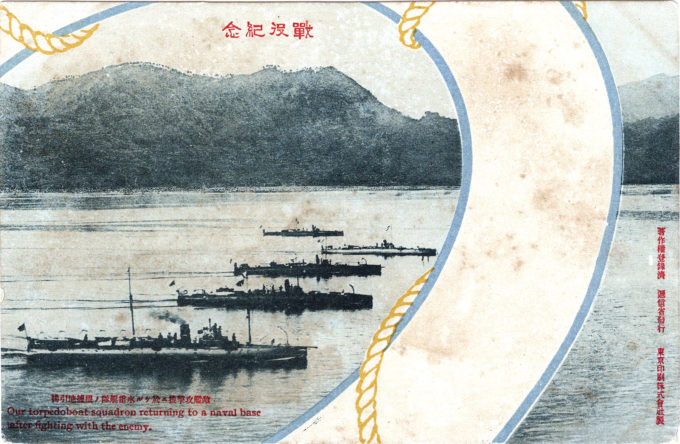
“Our torpedo boat squadron returning to a naval base after a night attack against the enemy”, I.J.N. torpedo boat squadron, Russo-Japanese War, c. 1904.
“Night had fallen. The sea off Port Arthur lay flat and gleaming like an enormous field of coal. The only disturbance for miles around was a foaming path, slowly being plowed across this black waste by a column of 11 torpedo boats bearing the insignia of Imperial Japan.
“… Captain Shojiro Asai, the officer in command of the squadron, stared intently ahead, searching the chill night for an unseen enemy. His fellow officers did likewise, gripped with the knowledge that they were embarked on a historic mission.
“The date was 8 February 1904. Czarist Russia and Imperial Japan, long in contention for the mastery of East Asia, were finally on the brink of war. Ambassadors had been recalled from Moscow and Tokyo. The world waited with a thrill of horror for the news that a state of war existed—but as yet, there had been no such declaration.
“… [B]y the night of 8 February, a Japanese surprise-attack fleet consisting of six of the world’s heaviest and most modem battleships, six first-class cruisers, four second-class cruisers, and 18 torpedo boats lay off Round Island, 60 miles east of Port Arthur. At precisely 1815, Togo signaled the torpedo boats to leave the main fleet and attack the Russian warships in their anchorages. ‘Blow up the enemy squadron,’ his message concluded. ‘I wish you success!’ A wild cheer went up throughout the flotilla. There were hoarse cries of ‘Banzai!’ Swords cleaved the air, and champagne and sake were quaffed with great gusto.
“… [Squadron commander] Captain Asai selected as his target the biggest dark blotch he could make out through the falling snow. At a distance of 1,000 yards from this vessel, he reduced speed to dead slow so that the seemingly dozing enemy might not be alerted by a sparkling bow wave or the dull red flames that were apt to spout from a speeding boat’s funnels. No one spoke. The engines were almost soundless. There was only the soft creak of the steering wheel and the swish of water hissing around the long, sleek hull. The Japanese had not lost the advantage of surprise.
“… The most gallant performance of the action was that of Akatsuki, the fourth Japanese torpedo boat, commanded by Lieutenant Suyetsuga. He got as close as 400 yards to the first-class cruiser Askold, but held fire, hoping to find a battleship … Whether or not such sophisticated engineering could protect the ship from underwater attack was about to be tested as the Akatsuki, one of the older Japanese boats still fitted with a forward tube, bore down on her prey. At 0032 precisely, Lieutenant Suyetsuga fired his right-ahead tube.
“‘A great explosion followed,’ he later reported, ‘a huge column of water being thrown up alongside the battleship and [the Imperial Russian Navy] ships threw their searchlights everywhere.'”
– Nightmare at Port Arthur, by William H. Honan, Naval History Magazine, U.S. Naval Institute, August 1990

